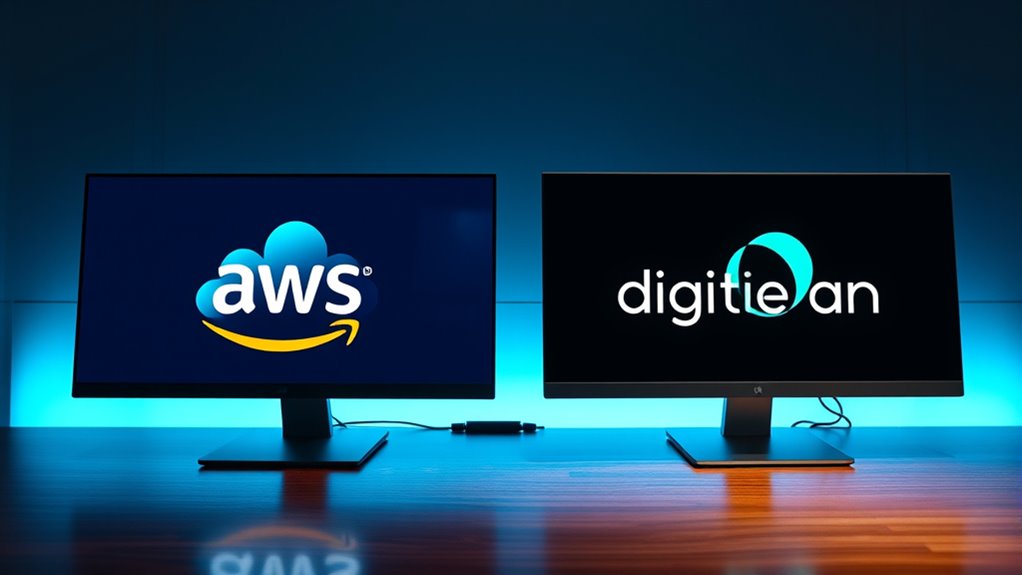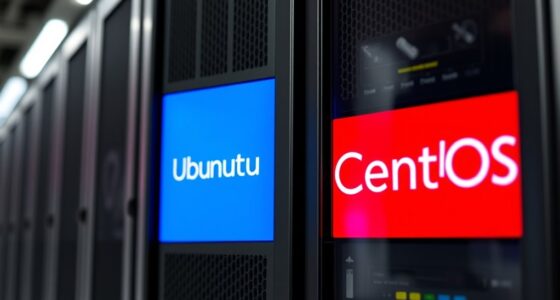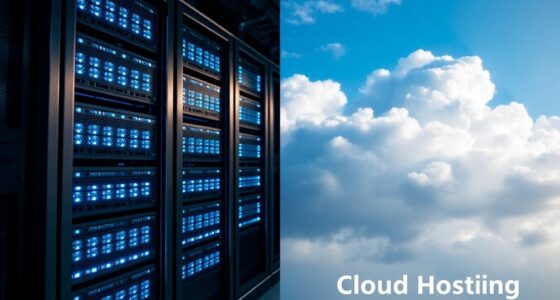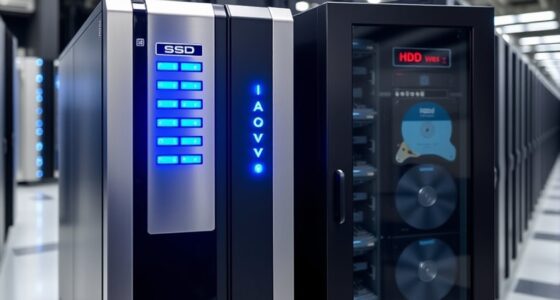If you’re choosing between AWS Lightsail and DigitalOcean Droplets for a budget-friendly cloud, consider your needs for ease of use, security, and scalability. Lightsail offers powerful features and solid security, but comes with a steeper learning curve and potentially higher costs. DigitalOcean provides simple, quick deployment suitable for smaller projects with straightforward security. To find the best fit for your project and budget, explore how each platform stacks up further.
Key Takeaways
- DigitalOcean Droplets generally offer simpler, more straightforward pricing and deployment, ideal for budget-conscious users seeking ease of use.
- AWS Lightsail provides advanced security and scalability features, but with potentially higher costs and complexity for small projects.
- DigitalOcean’s user-friendly platform makes it more accessible for beginners on a tight budget.
- Lightsail’s integration with AWS ecosystem offers more robust security options, suitable for users with stricter security needs.
- Overall, DigitalOcean Droplets tend to be more cost-effective for small to medium workloads, while Lightsail suits projects requiring advanced features.

When choosing a cloud hosting provider, understanding the differences between AWS Lightsail and DigitalOcean Droplets is essential. Both platforms target budget-conscious users but differ markedly in features like container orchestration and network security. If you’re planning to run multiple containers or microservices, you’ll want to contemplate how each handles container management. AWS Lightsail offers integration with Amazon Elastic Container Service (ECS), allowing you to orchestrate containers at scale with robust tools, but it may require more setup and familiarity with AWS’s ecosystem. DigitalOcean, on the other hand, provides a straightforward container management solution through DigitalOcean Kubernetes (DOKS), which is easier to deploy and manage for smaller projects or those new to container orchestration. Your choice depends on your comfort level and the complexity of your deployment needs.
Network security is another critical aspect when comparing these providers. AWS Lightsail benefits from Amazon’s extensive security infrastructure, including virtual private clouds (VPCs), security groups, and encryption options, giving you granular control over your network. These features help safeguard your data and applications from unauthorized access, which is especially important if you’re handling sensitive information. DigitalOcean also emphasizes security with features like private networking and firewalls, but its security tools are generally simpler and easier to configure. While both platforms offer essential protections, if your project requires advanced security measures and compliance, AWS Lightsail’s infrastructure might be the better choice, despite its steeper learning curve. Additionally, the color accuracy and contrast ratio of your hosting environment can impact how well your applications perform visually, especially for user interfaces and graphical content.
AWS Lightsail offers advanced security features like VPCs and encryption, providing granular control over your network.
Performance and scalability are tied closely to these features. Lightsail’s integration with AWS’s broader ecosystem means you can scale up easily and leverage advanced security options, but it might come with additional complexity and cost. DigitalOcean’s platform is designed for simplicity and quick deployment, making it ideal for small to medium projects where ease of use is a priority. If container orchestration and network security are top concerns, your decision will hinge on how much control versus simplicity you need. Lightsail provides more powerful tools and customization but at a potentially higher learning curve and cost. DigitalOcean offers a more user-friendly experience with enough security features for most small to medium workloads.
Ultimately, both options serve budget-minded users well, but your specific needs around container orchestration and network security will guide the best fit. If you prefer a platform with more advanced features and are willing to navigate a steeper setup process, AWS Lightsail might be your best choice. If ease of use, quick deployment, and straightforward security are more important, DigitalOcean is a compelling alternative. Each platform balances cost, features, and complexity differently, so consider your project’s scope and your technical expertise before making a decision.
Frequently Asked Questions
How Do Their Customer Support Services Compare?
When comparing their customer support services, you’ll find that AWS Lightsail offers extensive technical support options, including 24/7 access for enterprise plans and detailed documentation. DigitalOcean provides quick response times through community forums, ticketing, and chat support, but may lack the same level of dedicated support. Your choice depends on whether you prefer personalized technical support or rely on fast community-driven assistance for troubleshooting.
Which Provider Offers Better Scalability Options?
Think of your cloud provider as a sturdy ship charting stormy seas. When it comes to scalability, you want a vessel that adapts smoothly. DigitalOcean offers limited auto scaling capabilities, requiring manual adjustments, but provides solid resource flexibility. AWS Lightsail, on the other hand, has better auto scaling options, allowing you to grow seamlessly. Your choice depends on whether you prefer manual control or automated expansion to keep your journey smooth.
Are There Any Hidden Costs With Either Service?
You want to know if either service has hidden costs. Both AWS Lightsail and DigitalOcean prioritize pricing transparency, but occasional billing surprises can happen if you don’t monitor usage carefully. DigitalOcean’s straightforward flat-rate pricing makes it easier to predict costs, while Lightsail offers bundled plans. To avoid surprises, regularly review your bills and understand what’s included in your plan, ensuring you stay within your budget.
How Do Their Security Features Differ?
You might think both services offer similar security, but they actually differ in key ways. Lightsail provides simplified firewall customization and integrated security monitoring, making it user-friendly for beginners. DigitalOcean offers more granular firewall controls and third-party security tools for advanced users. These differences mean your security setup can be tailored to your needs, ensuring better protection and monitoring depending on your technical skills and security priorities.
Which Platform Has a Larger Community or User Base?
You’ll find that DigitalOcean has a larger community size and higher user engagement, making it easier to find tutorials, forums, and support. Its active user base fosters a vibrant environment where you can quickly get help and share ideas. While AWS Lightsail’s community is growing, DigitalOcean’s more dedicated community means you’ll benefit from more resources, community projects, and peer support to troubleshoot and optimize your cloud experience.
Conclusion
Choosing between AWS Lightsail and DigitalOcean Droplets is like picking between two stars in the cloud universe; both shine brightly, but your choice depends on your specific needs. If you want seamless scalability and robust features, Lightsail might be your guiding light. On the other hand, if simplicity and cost-effectiveness are your compass, DigitalOcean could be your steady anchor. Whichever you choose, remember, your cloud journey is only just beginning.









